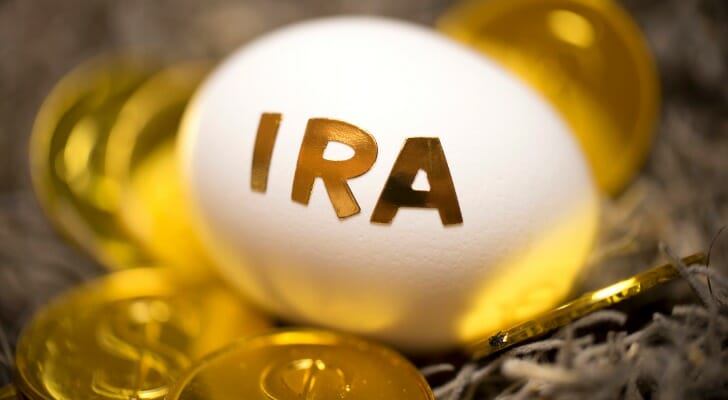How Do I Withdraw Money From My Ira?

Under normal circumstances, you cannot withdraw money from your traditional individual retirement account (IRA) without facing a penalty tax until you reach age 59.5. You can, however, avoid this sanction if you make an IRA hardship withdrawal. The IRS typically allows this when you need the money to cover certain expenses, like substantial medical bills or education debt. SmartAsset can also help you find a local financial advisor to guide you through all of your options.
IRA Hardship Withdrawal Rules
The IRS allows you to make penalty-free withdrawals from your traditional IRA once you reach age 59.5. Otherwise, you'd owe a 10% early withdrawal penalty in addition to ordinary income taxes. However, the IRS waives the 10% penalty in certain situations. Generally speaking, you can take an IRA hardship withdrawal to cover the following expenses:
- Unreimbursed medical expenses that exceed more than 7.5% of adjusted gross income (AGI) or 10% if younger than 65
- Qualified higher education expenses
- Purchasing your first-home that doesn't exceed $10,000
- Certain expenses if you're a qualified military reservist called to active duty
But keep in mind that traditional IRAs are tax-deferred savings vehicles. This means that you'd always owe income tax on any withdrawals you make. An IRA hardship withdrawal just spares you the 10% early withdrawal penalty. Plus, you can't withdraw more than you need to cover your financial burden.
If the account holder of an IRA dies, his or her beneficiaries may take penalty-free hardship withdrawals in most cases. However, the surviving spouse may face the penalty if he or she decides to turn the inherited IRA into a personal one and makes a withdrawal before reaching age 59.5.
IRA Hardship Withdrawals for Medical Expenses
If you've racked up a serious medical bill, you may be able to tap into your IRA penalty-free to cover it. The IRS allows you to take a hardship withdrawal to pay for unreimbursed qualified medical expenses that don't exceed 10% of your adjusted gross income (AGI). This represents your taxable income minus specific deductions you claim such as student loan interest paid for the year.
Fortunately, qualified medical expenses fall under a relatively large umbrella. It covers most medical, dental and vision treatments that diagnose, prevent or treat disease.
The rules generally allow you to take an IRA hardship withdrawal to cover most annual checkups, prescriptions and surgeries. However, qualified medical expenses typically don't include procedures you chose to take but don't need such as most plastic surgeries.
In addition, you have to take the IRA hardship withdrawal during the same calendar year that you incurred your medical bills. So let's say you have surgery coming up next year. You can take the hardship withdrawal now as long as you use it to pay for the surgery before the end of the year. And that holds true even even if you won't actually go through the procedure until next year. As long as you follow this rule, you can include those medical expenses in your tax return along with Form 5329 to avoid the 10% early withdrawal penalty. However, you don't have to itemize deductions.
You can also take a penalty-free hardship withdrawal if you've experienced "total and permanent disability." One of the easiest ways you can prove this and avoid the early withdrawal penalty is by taking disability payments from an insurance company or through Social Security.
IRA Hardship Withdrawals for Health Insurance Premiums
If you've been unemployed for at least 12 weeks, you can take an IRA hardship withdrawal to pay for health insurance premiums. To keep a clean record, however, you should consider sending the payments directly to the insurance carrier.
You should also transfer the withdrawal into a separate bank account and use it to cover your premiums.
IRA Hardship Withdrawals for First-Time Homebuyers

Considering owning your home anticipating trouble paying off your mortgage? The IRS offers a solution. You can take an IRA hardship withdrawal to pay it down. But you can only do so if you haven't owned another home in the last two years.
However, this kind of withdrawal can't exceed $10,000. That's your lifetime limit. So you can take out multiple withdrawals to cover the costs associated with purchasing a home. But the combined total can't be more than $10,000 in order to avoid the penalty.
IRA Hardship Withdrawals for College Expenses
The IRS allows you to take early withdrawals from your traditional IRA penalty free in order to cover qualified higher education expenses at postsecondary schools. That basically covers anything beyond high school including vocational schools. You can typically use your hardship withdrawal to pay for the following:
- Tuition
- Books and supplies needed for enrollment
- Room and board
You can use the hardship distribution to pay for qualified higher education expenses you, your children or other immediate family members incur.
However, the student benefiting from the distribution must be enrolled at a postsecondary school at least half time while pursuing a degree. Otherwise, the IRA owner can't avoid the early withdrawal penalty.
In addition, you must pay the qualified education expenses during the same year you withdrew funds from your traditional IRA in order to steer clear from the penalty.
However, taking an IRA hardship withdrawal to pay for qualified education expenses may affect the student's eligibility for financial aid. When you take money out of your IRA and cover educational expenses, the government factors in the withdrawal as the student's income for the following year. This means it could have a substantial impact when filling out the Free Application for Federal Student Aid (FAFSA).
But if you're worried about future educational expenses, you may benefit by opening a 529 college savings plan. These state-sponsored savings vehicles offer several tax breaks. For instance, you can take money out of the plan tax-free at any time in order to pay for qualified higher education expenses.
Substantially Equal Periodic Payments (SEPP)
A special rule in the tax code allows you to make penalty-free withdrawals from a traditional IRA even if you're younger than 59.5. You can take advantage of this rule by taking at least five substantially equal periodic payments (SEPP) based on your life expectancy as set by the IRS.
You must take these payments throughout the course of five years or until you reach age 59.5, whichever lasts longer. In addition, the payment amount has to be based on one of the three following IRS-approved methods:
- Amortization: Your payment reflects the amortization of your plan's balance throughout a single or joint life expectancy. Each payment is fixed.
- Minimum Distribution: You take your balance and divide it by a certain factor taken from the IRS single or joint life expectancy table. Thus, the amount can vary from year to year.
- Annuity Factor Method: You take your IRA account balance and divide it by an annuity factor based on the IRS mortality table and "reasonable" interest rates up to 120% of the mid-term applicable federal rate at the time you make the calculation.
Bottom Line

Tapping into your retirement plan in case of emergency should be your last resort. But there are plenty of ways to minimize the hit. For instance, you generally can avoid early withdrawal penalties if you use the money to cover a substantial qualified medical or higher education expense. However, you'd still owe income tax on the withdrawal amount any time you take money out of a traditional IRA. You must also report allowable hardship withdrawals on your tax return.
Tips for Making IRA Hardship Withdrawals
- Because of tax rules and potential penalties, you have to be extra careful when taking a hardship withdrawal from your traditional IRA. A financial advisor can walk you through this process, while also helping you with investing and financial planning. To find a financial advisor in your area, use SmartAsset's free matching tool.
- To avoid early withdrawal penalties from the IRS, you need to report allowable hardship distributions on Form 5329. Fortunately, tax filing software has made this task much simpler. Check out SmartAsset's guide to the best tax filing software available.
Photo credit: ©iStock.com/LumineImages, ©iStock.com/PeopleImages, ©iStock.com/Kameleon007
Javier Simon, CEPF® Javier Simon is a banking, investing and retirement expert for SmartAsset. The personal finance writer's work has been featured in Investopedia, PLANADVISER and iGrad. Javier is a member of the Society for Advancing Business Editing and Writing. He has a degree in journalism from SUNY Plattsburgh. Javier is passionate about helping others beyond their personal finances. He has volunteered and raised funds for charities including Fight Cancer Together, Children's Miracle Network Hospitals and the National Center for Missing and Exploited Children.
How Do I Withdraw Money From My Ira?
Source: https://smartasset.com/retirement/ira-hardship-withdrawal
Posted by: alfordbrebrugh.blogspot.com

0 Response to "How Do I Withdraw Money From My Ira?"
Post a Comment